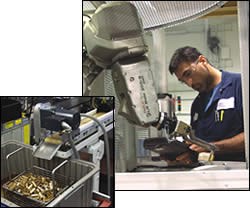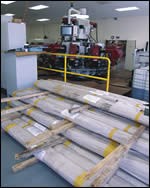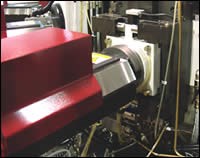The Hammond Way
Embracing innovation is part of the culture in this California production shop. Its founder takes competition and technical challenges as quests that demand creative solutions from man and machine.
Al Hammond exemplifies the quintessential American success story. He’s a guy who literally started in his garage and built a successful manufacturing organization despite the odds. In 1989 he walked away from a position at Lockheed Martin (formerly Lockheed Missle & Space Co.), that gave him the opportunity to do machining and manufacturing engineering work on such high profile projects as the space shuttle, the Hubble Telescope and stealth fighters in order to pursue his dream at home in his garage. He’d seen how the “big boys” did machining. “Lockheed was absolutely the best technical training facility in the world,” Mr. Hammond stated. “It had all the latest technology advances, and you learned how to use it all.”
So the move to the garage was not some uncalculated leap of faith. No, Mr. Hammond always has a plan. His two-car garage was already tightly stocked with an engine lathe, band saw, a conventional Bridgeport mill and a non-toolchanger CNC Hurco. Besides his knowledge and will, Mr. Hammond had another important thing going for him: a customer base that already relied on his expertise and quality products. For the previous 2 years, Hammond had spent evenings and 12-hour Saturday and Sunday shifts manufacturing low quantities and one-off parts for the medical industry. Now, he was ready to build his own company.
Throttling Up
Only 6 months later, Hammond Enterprises, bursting at the seams, moved from the garage into a 600-square-foot space in an industrial park. “At the time, I thought ‘How will I ever fill this place up?’ ” Mr. Hammond reminisced with a laugh.
Opportunity came knocking while the company was still doing R&D medical parts with 100-piece-run maximums. It came in the form of a “serious” production run when an urgent request for 5,000 parts came from a customer whose in-house machine broke down. Eventually, after successfully completing that request and others like it, all of that customer’s work came his way.
Consequently, Mr. Hammond found the need to expand, and in 1994, found his current spot in Pittsburg, California. Expanding its machining capabilities, Hammond started buying more mills and single-spindle lathes, then Indexes and Traubs and later a Hydromat, bringing the shopfloor total to 22 machines.
They now have 20-plus employees, some following Mr. Hammond and coming from Lockheed through the years. They have celebrated 15 straight years of continued growth, even through the manufacturing downturn between 2001 and 2003. Mr. Hammond shows pride when he states, “We never lost a job to China.”
Lock And Load
That first “volume” order led Hammond Enterprises to become a significant producer of brass commercial security lock parts in California and throughout the U.S., and the company is quite successful in the world market. It’s 60 percent of the company’s production.
The commercial security lock industry, unlike home lock products, has stringent specifications concerning quality. Security locks are manufactured from all machined parts, while the residential parts are cast. Many lock units with Hammond parts in the assembly are tested 10,000 times while checking for failures. Manufacturing investments, like the addition of the Hydromat, speed production, and online scheduling helps Hammond’s customer know where each of 100 different parts are in an ever more complex production process. This helps make Hammond the number one turned parts supplier for their customer’s security lock business.
The rest of the shop’s work is in medical and to a lesser extent, work for the aerospace and semiconductor industries. Looking forward, Mr. Hammond hopes to use Hydromat machines for medical parts. “Those types of volumes are coming,” he says. “Someday we’ll probably be manufacturing titanium bone screws on a Hydromat.” For the time being, the Hydromat will continue to chew through the brass all day long.
Technology First
Lockheed’s emphasis on new technology seems to have seeped into Mr. Hammond’s psyche, helping create his manufacturing philosophy. He says, “The keys are to always try to stay on the edge of technology. Use automation, work on high-tolerance jobs and stay away from ‘the easy stuff.’ “ His success can be attributed not only to a high quality standard, but meticulous attention to the costs of running the business, including materials and manpower, all the way down to the cost of his shop air. He doesn’t miss a trick.
Mr. Hammond moved into rotary transfer machining about 3 years ago with the intention to automate an area of his high-volume lock part business. The part was made from extruded brass and was previously done in two operations on a mill with a cycle time of 2 minutes, 30 seconds. When the customer needed more and more quantities, Mr. Hammond acquired his Hydromat, and the part is now produced complete with a 9-second cycle time. The version of the Epic R/T HS-12 he bought features vertical indexing chucks positioned around the rotary table.
In the job, changes to the lock design required even more volume and tighter tolerances. Hydromat engineered a robot for unloading the parts, eliminating the previous pneumatic handler, which added an additional cutting station to the end of the operation sequence. In the retrofit, more three-axis flanges were added for a total of seven, giving Hammond the flexibility it needs for future applications. To meet the demand for as many as 2.2 million parts a year, the machine now runs 24/7 and is booked “from now to forever,” Mr.
Hammond says.
The lock assembly requires the use of a number of pins to move freely, yet with very tight tolerances. The previous manufacturing method used by its customer was to line drill the three-piece unit after it had been assembled at the plant. Now the drilling is done during cutting operations, eliminating the secondary operations the customer used to do. The flexibility of the newer Hydromat concept had benefits over the older version.
Learning By Doing
“The Hydromat keeps the per-part cost low so we can compete with overseas parts manufacturers,” states Chris Horton, plant manager, who left Lockheed and joined Hammond 10 years ago. Mr. Horton demands that his machines are well maintained and run according to plan. “The Hydromat is running at about 85-percent capacity right now, but we like it to be lower.” Lower? “We want it to be running perfectly at all times. That’s priority number one, and so far it has,” Mr. Horton says. “We factor in time for maintenance, and we back off feeds and speeds for tool life and product quality. We’re not pushing anything.” Recently, after calculating the demand that could come their way from the lock industry, they found that a second Hydromat would become essential. “The demand worked out to be 75 weeks a year on our Hydromat production. That’s impossible, so we had to reign it in for now and plan ahead,” Mr. Horton noted. “We don’t want uncontrolled growth—it can kill you.”
Mr. Horton has mixed emotions about wanting to push it up to 100-percent capacity. “From a plant perspective, I want to make as much product as possible, but we don’t want to cut years out of the Hydromat’s life, and we don’t want a breakdown to happen.” The customer’s demand for product dictates that the Hydromat needs to run 20 to 22 hours a day, and with Horton’s method it has done just that. “At first, we approach production on a new machine gingerly; we may only load six bars for lights-out production. I’ll check the last part. If it’s good, the tub is good. Once we’re confident we’ll run it all night.” The run-up to a full production mode is one done methodically. “Later we’ll step it up, trying new tools, new feeds and speeds to help expedite cycle times,” Mr. Horton adds.
Recently, he added a new chip hopper/spinner technology, which allows for a significant reduction in the loss of cutting oil that was escaping with the brass that drops from the Hydromat’s chip conveyor. It can be as much as 5,000 pounds a day. A 12- to 15-percent oil loss is now down to 1 percent after being processed through the new spinner, and Mr. Hammond is showing an annual savings of about $100,000 in reclaimed oil. These simple technological advances add to the bottom line, and this team is always on the lookout for ways to improve.
The Hammond Way
Mr. Horton finds his job challenging. “We’re not afraid of technology. It can only help our customers. We can produce a better product in less time.” He continues, “We’re in business with the security (lock industry because nobody can touch our prices, and off-shore can’t compare with our quality.” However, like other areas of the country, finding the right people to produce quality products is an issue in California. “The challenge is labor. In my 10 years with Hammond, I’ve only had one person knock on my door and say they wanted to learn the trade. Mr. Horton remarks, “Everybody is an operator, but getting people who know the difference between an end mill and a reamer—it’s hard—so we take people in and train them to do what we call ‘true machining the Hammond way.’ ”
And what happened to the worker who knocked on Hammond’s door looking to learn the trade? Mr. Horton proudly explains, “He is now the guy who is running our Hydromat. He was spraying vegetables at Safeway 6 years ago. He came in as a laborer and apprentice. He’s a very sharp guy who absorbed everything, and now he’s our rotary transfer guru.”
Making It Work
A few years ago Hammond was looking to expand its capabilities into screw machines. When an auction in the Bay Area offering about eight machines was scheduled, Mr. Hammond and a couple of his employees went looking. “There were several colleagues all standing around, and when they saw us they asked what we were doing there,” he recalls. “I told them we were trying to buy one of these screw machines, and they thought we were crazy. They told us that business was gone to China.” Mr. Hammond replied, “I don’t even know how to turn one of these on, but when I get one, I’ll have five more. Because my philosophy in business is not the same as yours, I’m not here to say, ‘let the business be taken over.’ Instead, I’m here to say, ‘what do I have to do to make it work?’ Everyone was astounded that I would buy something that I didn’t know how to run yet.”
Confident in his ability to find a way, Mr. Hammond feels he can make some metalcutting technologies pay off for him where others have failed. “We have smart people in America, we just have to learn how to reapply what we know,” Mr. Hammond concluded. He and his team then set out to make it a little bit better. Hammond now owns five Traubs, and they run around the clock. And what happened to the naysayers at the auction? Those companies are gone.
“I can apply my 25 years of experience to any technology and make it work. The manufacturers have service people, they have training people, there’s always help to be had. Right?” Mr. Hammond asks. When he decided to get into the Swiss turning business, he did it “the Hammond way.” “You should step up and buy a good machine. We hadn’t done Swiss turning before, but there’s no need to buy a low-end Swiss machine. We got the best we could—a Tornos,” he explains. Now it runs every day and has made the same part for 2 years at 600,000 parts per year. Not a bad investment.
Hammond Enterprises is a family-owned business, and Mr. Hammond can be found right out on the floor with the other workers. If something is spilled on the floor and the technicians don’t have a chance to clean it up, he will. There’s nothing that he and his management team would ask an employee to do that they wouldn’t do themselves. “If someone doesn’t like pulling parts and putting them in a box all day, then we’ll go out and find some technology to do it.” There isn’t always an easy fix, however. Mr. Hammond says, “Sometimes the technology isn’t there, so you just have to hit the anvil with the hammer. You don’t have to like it, but you have to do it. If we can find a better way, then we invest in the technology, and we always see the payoff.”
Related Content
Tips for Troubleshooting and Repairing Chip Conveyors
A nonfunctioning chip conveyor can cause a high-production machine to be down for an extended period of time. Here is some troubleshooting advice if you’re having issues with your chip conveyors.
Read MorePursuit of Parts Collector Spearheads New Enterprise
While searching for a small parts accumulator for Swiss-type lathes, this machine shop CEO not only found what he was looking for but also discovered how to become a distributor for the unique product.
Read MoreStarting Small with Automation
Quick-change workholding and flexible robotic automation started this small shop on the path to success.
Read MoreAutomation Breakthroughs Revolutionize Precision Machining for Complex Parts
Marubeni Citizen-Cincom delivers custom solutions to address some of the biggest challenges in precision machining from handling small parts, to robot integration and unique tooling needs.
Read MoreRead Next
Scalable Transfer Machine Offers Flexible Solutions
Mikron Machining Technology (Monroe, Connecticut) now offers the NRG-50 rotary transfer machine, which provides new dimensions in the cost-efficient production of large-volume series. The machines are designed for prismatic parts with an edge length of as much as 50 mm or, alternatively, 35-mm diameter and 70-mm length.
Read More5 Aspects of PMTS I Appreciate
The three-day edition of the 2025 Precision Machining Technology Show kicks off at the start of April. I’ll be there, and here are some reasons why.
Read MoreA Tooling Workshop Worth a Visit
Marubeni Citizen-Cincom’s tooling and accessory workshop offers a chance to learn more about ancillary devices that can boost machining efficiency and capability.
Read More


























